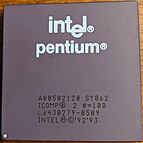iCOMP (index)
iCOMP=319
iCOMP = 435
iCOMP = 510
iComp = 815
iCOMP = 1000
iCOMP 2 = 100
iCOMP 2 = 111
iCOMP 2 = 114
iCOMP for Intel Comparative Microprocessor Performance was an index published by Intel used to measure the relative performance of its microprocessors.
Intel was motivated to create the iCOMP rating by research which showed that many computer buyers assumed that the clock speed – the “MHz” rating – was indicative of performance, regardless of the processor type. iCOMP ratings based on standard benchmarks.[1] The formula for calculating iCOMPs is like this:
| Category | Benchmark | Weight |
|---|---|---|
| 16-bit Integer | ZDbenchCPU | 52% |
| 16-bit Floating-Point | 16-bit Whetstone | 2% |
| ZDbenchCPU | 1% | |
| 16-bit Graphics | ZDbenchCPU* | 10% |
| 16-bit Video | ZDbenchCPU* | 5% |
| 32-bit Integer | SPECint92 | 15% |
| 32-bit Floating-Point | SPECfp92 | 5% |
| 32-bit Graphics | SPECint92* | 5% |
| 32-bit Video | SPECint92* | 5% |
The largest component is the integer CPU benchmark from Ziff-Davis Labs (ZDbenchCPU), which is derived from the earlier PC Labs benchmarks. Whetstone (as implemened in PowerMeter) is used for 16-bit floating-point, and SPECint92 and SPECfp92 are used for the 32-bit components.[1]
There were three revisions of the iCOMP index. Version 1.0 (1992) was benchmarked against the 486SX 25, while version 2.0 (1996) was benchmarked against the Pentium 120.[2] For Version 3.0 (1999) it was Pentium II at 350MHz.[3]
| CPU Name | Speed (MHz) | iCOMP 3.0 | iCOMP 2.0 | iCOMP 1.0 |
|---|---|---|---|---|
| Pentium III | 1000 | 3280 | ||
| 933 | 3100 | |||
| 866 | 2890 | |||
| 800 | 2690 | |||
| 750 | 2540 | |||
| 700 | 2420 | |||
| 650 | 2270 | |||
| Pentium III E | 600 | 2110 | ||
| Pentium III | 600 | 1930 | ||
| 550 | 1780 | |||
| 500 | 1650 | |||
| 450 | 1500 | |||
| Pentium II | 450 | 1240 | 483 | |
| 400 | 1130 | 440 | ||
| Celeron | 400 | 1011 | 394 | |
| Pentium II OverDrive | 333 | 1001 | 387 | |
| Pentium II | 350 | 1000 | 386 | |
| 333 | 940 | 366 | ||
| Pentium II OverDrive | 300 | 351 | ||
| Celeron | 366 | 890 | 344 | |
| Pentium II | 300 | 332 | ||
| Celeron | 333 | 318 | ||
| Pentium II | 266 | 303 | ||
| Celeron A | 300 | 296 | ||
| Pentium II | 233 | 267 | ||
| Celeron | 300 | 226 | ||
| Pentium Pro 256K | 200 | 220 | ||
| Celeron | 266 | 213 | ||
| Pentium MMX | 233 | 203 | ||
| Pentium Pro 256K | 180 | 197 | ||
| Pentium Pro 512K | 166 | 186 | ||
| Pentium MMX | 200 | 182 | ||
| Pentium OverDrive MMX 200 | 200 | 181 | ||
| Pentium Pro 256K | 150 | 168 | ||
| Pentium OverDrive MMX 180 | 180 | 163 | ||
| Pentium MMX | 166 | 160 | ||
| Pentium OverDrive MMX 166 | 166 | 157 | ||
| Pentium MMX | 150 | 144 | ||
| Pentium OverDrive MMX 150 | 150 | 144 | ||
| Pentium | 200 | 142 | ||
| 166 | 127 | 1308 | ||
| Pentium OverDrive | 166 | 127 | 1308 | |
| Pentium OverDrive MMX 150 | 125 | 120 | ||
| Pentium | 150 | 114 | 1176 | |
| Pentium OverDrive | 150 | 114 | 1176 | |
| Pentium | 133 | 111 | 1110 | |
| Pentium OverDrive | 125 | 1070 | ||
| Pentium | 120 | 100 | 1000 | |
| Pentium OverDrive | 133 | 84 | 970 | |
| 120 | 75 | 877 | ||
| Pentium | 100 | 90 | 815 | |
| 90 | 81 | 735 | ||
| 75 | 67 | 610 | ||
| Pentium OverDrive | 83 | 581 | ||
| Pentium | 66 | 57 | 567 | |
| 60 | 51 | 510 | ||
| Pentium OverDrive | 63 | 443 | ||
| i486 DX4 | 100 | 435 | ||
| 75 | 319 | |||
| i486 DX2 | 66 | 297 | ||
| i486 DX | 50 | 249 | ||
| i486 DX2 | 50 | 231 | ||
| i486 SX2 | 50 | 180 | ||
| i486 DX | 33 | 166 | ||
| i486 SX | 33 | 136 | ||
| i486 DX | 25 | 122 | ||
| i486 SX | 25 | 100 | ||
| 20 | 78 | |||
| i386 DX | 33 | 68 | ||
| i486 SX | 16 | 63 | ||
| i386 DX | 25 | 49 | ||
| i386 SL | 25 | 41 | ||
| i386 SX | 25 | 39 | ||
| 20 | 32 | |||
| 16 | 22 |
See also
- PR rating
References
- ↑ 1.0 1.1 Michael Slater (October 7, 1992). "Intel Unveils “iCOMP” Performance Index". Microprocessor Report (MicroDesign Resources) 6 (13). https://websrv.cecs.uci.edu/~papers/mpr/MPR/ARTICLES/061302.pdf.
- ↑ "iCOMP(R) Index 2.0". http://faculty.iima.ac.in/~jajoo/icomp/icomp.htm.
- ↑ "Intel(r) Processor Performance Indicators". 1999-02-25. http://www1.intel.com:80/procs/perf/icomp/index.htm.
- ↑ "IDEAS Top Performers - Intel iCOMP (Full List)". Ideas International. http://www.ideasinternational.com/benchmark/intel/icomp.html.
 |









